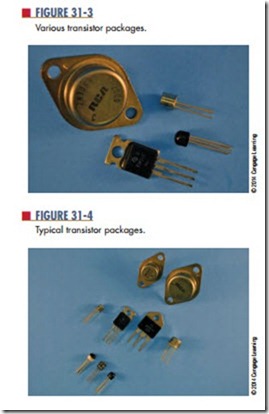Transistor Types and Packaging
Transistors are classified by the following methods:
1. According to type (either NPN or PNP)
2. According to the material used (germanium or silicon)
3. According to major use (high or low power, switching, or high frequency)
Most transistors are identified by a number. This number begins with a 2 and the letter N and has up to four more digits. These symbols identify the device as a transistor and indicate that it has two junctions.
A package serves as protection for the transistor and provides a means of making electrical connections to the emitter, base, and collector regions. The package also serves as a heat sink, or an area from which heat can be extracted, removing excess heat from the transistor and preventing heat damage. Many different packages are available, covering a wide range of applications (Figure 31-3).
Transistor packages are designated by size and configuration. The most common package identifier consists of the letters To (transistor outline) followed by a number. Some common transistor packages are shown in Figure 31-4.
Because of the large assortment of transistor packages available, it is difficult to develop rules for identifying the emitter, base, and collector leads of each device. It is best to refer to the manufacturer’s specification sheet to identify the leads of each device.
Questions
1. How are transistors classified?
2. What symbols are used to identify transistors?
3. What purposes does the packaging of a transistor serve?
4. How are transistor packages labeled?
5. What is the best method for determining which leads of a transistor are the base, emitter, and collector?
Related posts:
Incoming search terms:
- packaging of transistor
- types of transister
- manufctural of electric tube and transistor mail
- transistors packaging
- transistor packaging
- transistor packages catergories
- transistor packages and its types
- transistor packages
- packaging of transistors
- packaging of tran
- meaning of TO package in transistors
- discuss the transistor outlinw type packaging
- different packages of transistor
